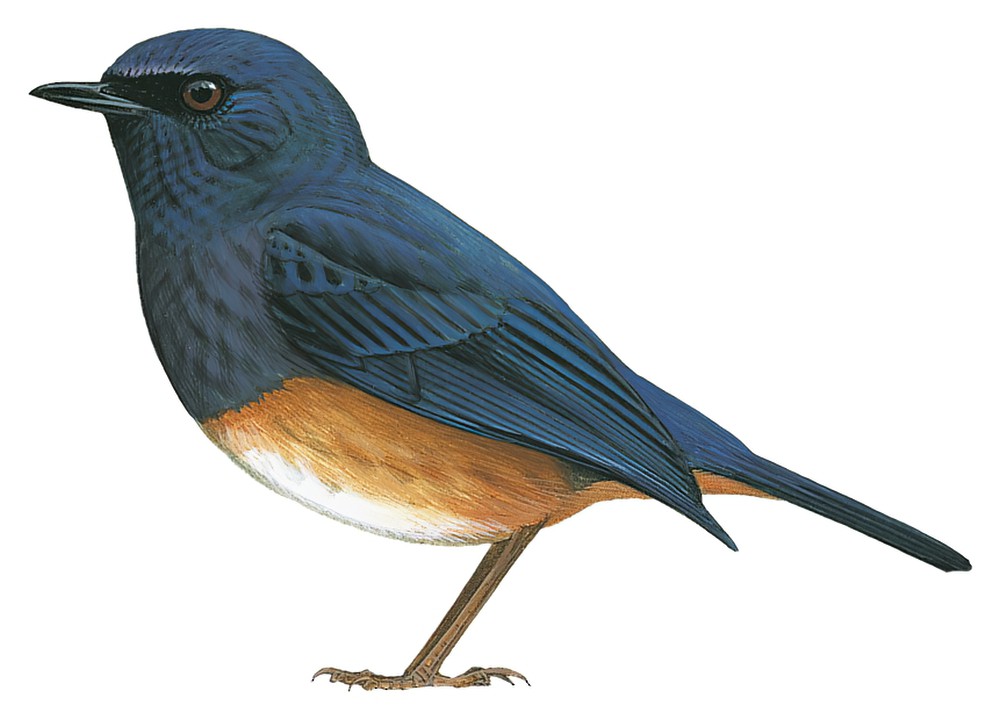Nilgiri Sholakili / Sholicola major

Nilgiri Sholakili
SCI Name:
Protonym: Phoenicura major MadrasJ.Lit.Sci. 13 p.170
Taxonomy: Passeriformes / Muscicapidae / Sholicola
Taxonomy Code: whbsho1
Type Locality: Nilgiris.
Author: Jerdon
Publish Year: 1841
IUCN Status: Endangered
DEFINITIONS
Sholicola
(syn. Myiomela Ϯ Nilgiri Blue Robin M. major) "Sholicola genus novum ... Type species: Phoenicura major Jerdon, 1841 ... Etymology: Sholicola, of masculine gender, is a combination of Shola (the local name [Tamil solai thicket, grove] for montane forests in the Western Ghats) and the suffix -cola (from the Latin verb "colere"), meaning "dweller"" (Robin et al. 2017).
major
L. maior, maioris greater, larger < comp. magnus great, large, powerful.
● ex “Poule d’eau de Cayenne” of d’Aubenton 1765-1781, pl. 352; “Even if [Statius Müller, 1776] ...should some day be repudiated by ornithologists on account of his carelessness and his apparent colour-blindness, then the proper name of the species would be Aramides major (Boddaert), founded on Daubenton’s plate” (Sharpe 1894) (syn. Aramides cajanea).
● ex “Grand Corbeau” of Levaillant 1800, pl. 51 (unident.;?Corvus sp.).
● ex “Crotophagus major” of Brisson 1760, “Grand bout de Petun” of d’Aubenton 1765-1781, pl. 102, fig. 1, “Ani des palétuviers” of Salerne 1767, and “Greater Ani” of Latham 1781 (Crotophaga).
● 54. PICUS. ... major. 10. P. albo nigroque varius, ano occipiteque rubro. Picus albo nigroque varius, rectricibus tribus lateralibus utrinque albescentibus. Fn. svec. 81. Picus varius major. Ges. av. 708. Aldr. ornith. l. 12. c. 32. Will. orn. 94. t. 21. Raj. av. 43. Alb. av. I. p. 19. t. 19. Frisch. av. . . t. 36. f. 1. Habitat in Europa." (Linnaeus 1758) (Dendrocopos).
● ex “Grande Egrette d’Amérique” of d’Aubenton, 1765-1781, pl. 925 (syn. Egretta garzetta).
● ex “Scolopax media” of Frisch 1733-1763, “Great Snipe” of Pennant 1768, and Latham 1785 (syn. Gallinago media).
● ex “Grand Indicateur, mâle” of Levaillant 1807, pl. 241, fig. 1 (syn. Indicator indicator).
● ex “Pie-grièche Blanchot” of Levaillant 1810, pl. 285 (syn. Malaconotus blanchoti).
● ex “An other sort of Loggerhead” of Sloane 1707-1725, “Sitta” or “Picus cinereus major, rostro curvo” of Ray 1713, “Grand Sittelle à bec crochu” of de Buffon 1770-1783, and “Great Nuthatch” of Latham 1781 (?syn. Myiarchus validus).
● ex “Parus major” of Gessner 1555, Belon 1555, Aldrovandus 1599, and Willughby 1676, “Fringillago”, “Great Titmouse” or “Ox Eye” of Ray 1713, and Albin 1731, and “Parus capite nigro, temporibus albis, nucha luteis” of Linnaeus 1746 (Parus).
● ex “Grèbe de Cayenne” of d’Aubenton 1765-1781, pl. 404, fig. 1, and “Grand Grèbe” of de Buffon 1770-1785 (Podiceps).
● ex “Barbican des côtes de Barbarie” of d’Aubenton 1765-1781, pl. 602 (syn. Pogonornis dubius).
● ex “Grande Quiscale” of Vieillot 1819 (Quiscalus).
● ex “Tangara des grands bois de Cayenne” of d’Aubenton 1765-1781, pl. 205 (syn. Saltator maximus).
● ex “Batara mayor” of de Azara 1802-1805, no. 211 (Taraba).
● ex “Macucagua” of Marcgrave 1648, Willughby 1676, and Ray 1713, “Perdix brasiliensis” of Brisson 1760, and “Magoua” of de Buffon 1770-1783 (Tinamus).
● ex “Trepadore grande” of de Azara 1802-1805, no. 241 (Xiphocolaptes).
UPPERCASE: current genus
Uppercase first letter: generic synonym
● and ● See: generic homonyms
lowercase: species and subspecies
●: early names, variants, mispellings
‡: extinct
†: type species
Gr.: ancient Greek
L.: Latin
<: derived from
syn: synonym of
/: separates historical and modern geographic names
ex: based on
TL: type locality
OD: original diagnosis (genus) or original description (species)












